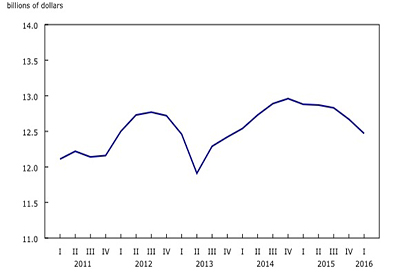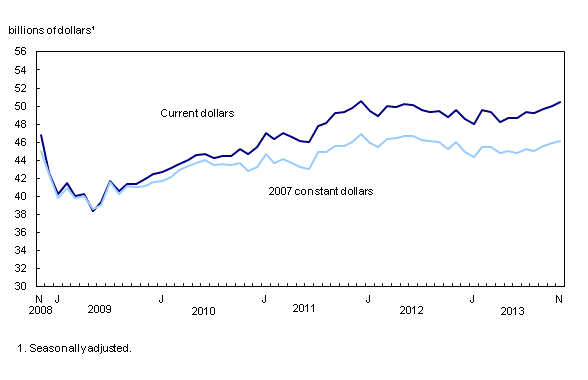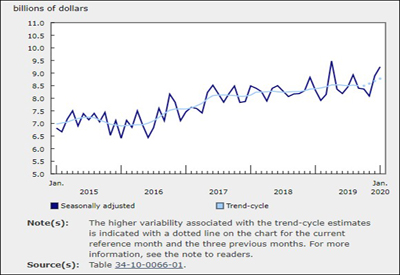November Records Significant Employment Gains in 6 Provinces
Dec 17, 2018
Employment rose nationally by 94,000 in November, driven by gains in full-time work. The unemployment rate decreased 0.2 percentage points to 5.6%, the lowest since comparable data became available in 1976.
In the 12 months to November, employment grew by 219,000 or 1.2%, reflecting gains in full-time work (+227,000 or +1.5%). Over the same period, total hours worked were up 2.1%.
Recently, Statistics Canada released the Labour Force Survey in brief: Interactive app, a new way to explore the most recent results from the Labour Force Survey.
Highlights
Employment increased in six provinces, led by Quebec and Alberta, and was little changed in the four Atlantic provinces.
More people worked in
• professional, scientific and technical services
• health care and social assistance
• construction
• business, building and other support services
• transportation and warehousing
• agriculture.
At the same time, fewer people worked in information, culture and recreation.
Employment increased for private sector employees, while it was little changed for public sector employees. The number of self-employed was also little changed.
Employment increased for both core-aged women and men (aged 25 to 54), as well as for older people (aged 55 and over) — driven by men.
Employment up in six provinces
In Quebec, employment rose by 26,000 in November, the result of more full-time work. The unemployment rate was little changed at 5.4%. Employment increased notably in professional, scientific and technical services; as well as in educational services. In the 12 months to November, employment was little changed in the province.
Employment grew by 24,000 in Alberta in November, boosted by gains in full-time work. At the same time, the unemployment rate fell 1.0 percentage point to 6.3%. In the 12 months to November, employment in Alberta rose by 59,000 (+2.6%).
In Ontario, employment increased by 20,000 compared with October, the result of gains in full-time work. The number of unemployed was little changed and the unemployment rate held steady at 5.6%. Compared with 12 months earlier, employment in the province increased by 66,000 or 0.9%, also due to more full-time work.
The number of employed people in British Columbia grew by 16,000 in November. The unemployment rate rose 0.3 percentage points to 4.4%. In the 12 months to November, employment in British Columbia increased by 43,000 (+1.7%).
There were 5,500 more employed people in Saskatchewan. The unemployment rate declined by 0.7 percentage points to 5.5%, the second decrease in three months. Compared with November 2017, employment grew by 15,000 (+2.7%).
In November, there were 2,600 more Manitobans employed. The unemployment rate fell 0.4 percentage points to 5.7%, as fewer people searched for work. On a year-over-year basis, employment rose 7,000 (+1.1%).
Industry perspective
In November, employment in professional, scientific and technical services increased by 26,000, led by Ontario and Quebec. On a year-over-year basis, employment was little changed in this industry.
In health care and social assistance, employment rose for the second consecutive month, up 19,000 in November. Most of the increase came from Alberta and Ontario. In the 12 months to November, employment in the industry increased 57,000 or 2.4%.
Employment in construction increased by 15,000, led by gains in British Columbia and tempered by a decline in Newfoundland and Labrador. Year over year, employment was little changed in the industry.
The number of people employed in business, building and other support services grew by 15,000 in November, the third increase in four months. Compared with 12 months earlier, employment in this industry rose by 60,000 (+8.0%).
In November, there were employment gains of 9,000 in the transportation and warehousing industry. These gains were concentrated in Ontario. Employment in this industry has been trending upward since April 2017. On a year-over-year basis, employment rose by 51,000 (+5.3%).
The number of people employed in agriculture increased by 7,100. Compared with November 2017, employment was little changed in the industry.
Employment declined in information, culture and recreation (-10,000 or -1.3%), continuing the downward trend that started in August. The decrease was driven by Ontario.
Compared with 12 months earlier, employment in this industry was down by 25,000 (-3.2%) at the national level.
Employment gains driven by private sector employees
In November, the number of private sector employees increased by 79,000, while it was little changed for public sector employees after declining in October. The number of self-employed was also little changed.
On a year-over-year basis, the number of private sector employees rose by 146,000 (+1.2%), while the number of public sector employees grew by 48,000 (+1.3%). Over the same period, there was little change in the number of self-employed workers.
More core-aged and older workers
Employment among those aged 25 to 54 was up 49,000 in November, the result of increases for both women (+32,000) and men (+17,000). The unemployment rate fell by 0.4 percentage points to 4.6% for core-aged women, and by 0.2 percentage points to 4.7% for core-aged men. In the 12 months to November, employment within this age group rose by 208,000 (+1.7%), largely the result of gains for women (+129,000).
In November, employment for those aged 55 and over grew by 39,000, driven by increases among men. As more people in this age group searched for work, their unemployment rate rose by 0.6 percentage points to 5.5%, the highest rate since November 2017. On a year-over-year basis, employment for this age group increased by 72,000 (+1.8%), also primarily the result of gains for men (+53,000).
Employment among youth aged 15 to 24 was little changed in November, and their unemployment rate was also little changed at 10.8%. Compared with November 2017, youth employment was down 61,000 (-2.4%), the largest year-over-year decrease since July 2016
Cannabis-related jobs: a budding source of employment
Non-medicinal cannabis became legal in Canada on October 17, 2018. The number of people employed in cannabis-related jobs in November was 10,400, an increase of 7,500 (+266%) from 12 months earlier. Employment in these types of jobs trended up throughout most of 2018. Estimates for this section are three-month moving averages and are not seasonally adjusted. See the note below for more details and definitions.
The majority (58%) of cannabis-related jobs in November 2018 were in the agriculture industry, where workers performed duties such as bud trimming. The rest of the employment was spread across a number of other industries such as educational services, health care, and retail trade.
The average hourly wage for employees in cannabis-related jobs was $29.58, higher than the national average ($27.03). Private sector employees accounted for the majority (83%) of these jobs.
More men than women worked in these jobs (79% compared with 21%). The median age was 35 years, younger than the median for workers in non-cannabis-related jobs (40 years). Virtually all of the employees were working full time and had permanent positions.
The highest level of cannabis-related employment was in Ontario, an estimated 5,700, representing more than half of the national total. Ontario is the province with the largest concentration of licensed producers.
Note: ‘Cannabis-related jobs’ refer to those in which a Labour Force Survey (LFS) respondent’s business name is on Health Canada’s list of approximately 120 licensed producers, or whose work description contains keywords such as “cannabis” or “marijuana.” These results do not reflect official industry or occupation classification standards, and are not seasonally adjusted. Data are presented as three-month moving averages. In April of this year, Statistics Canada published “A snapshot of licensed cannabis producers” using administrative records, which pegged employment at about 2,400 at the end of 2017. The estimates from the LFS may be higher for a number of reasons, such as the inclusion of unlicensed businesses.
Source: Statistics Canada, www150.statcan.gc.ca/n1/daily-quotidien/181207/dq181207a-eng.htm











